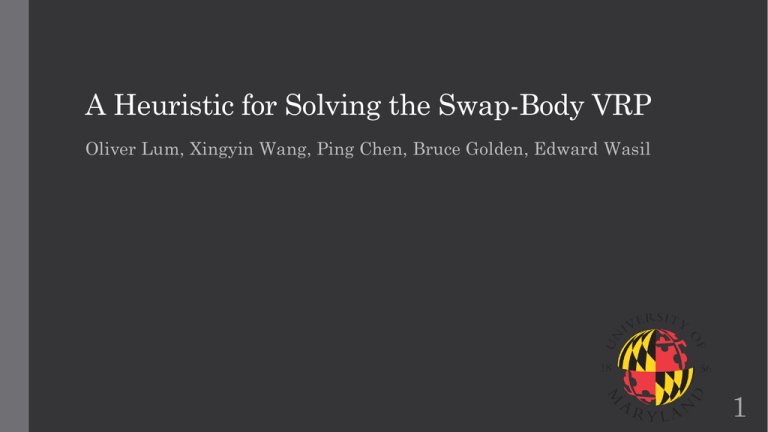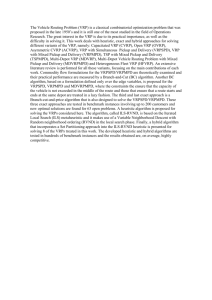ics2015_presentation_sbvrp_final
advertisement

A Heuristic for Solving the Swap-Body VRP
Oliver Lum, Xingyin Wang, Ping Chen, Bruce Golden, Edward Wasil
1
Swap-Body VRP
•
Models scenario in which the vehicles have detachable components, and
certain customers may be visited by only the smallest vehicle possible (due
to space constraints)
•
Single depot
•
Maximum route duration
Truck
Q = swap-body
capacity
Train
Figure 1: Truck, semi-trailer, and swap-body
Figure 2: Valid vehicle combinations (truck and train)
2
Related Problems
Gerdessen
Semet
Chao
Scheuerer
Lin et al.
Caramia and Guerriero
Villegas et al.
Yu et al.
Derigs et al.
Lin et al.
Lin et al.
Derigs et al.
Drexl
Drexl
• All single-objective
• Closest variant is the Truck and Trailer Routing Problem (TTRP)
• No dedicated swap locations
• Generally load transfer is allowed
• No vehicle fixed cost
3
Swap-Body VRP Cost
•
Vehicle Cost: Cost
of renting the
vehicle for use
•
Service Time
Cust.
Swap
Location
•
Time: An hourly
wage associated
with driver cost
•
Distance: A cost /
kilometer for use
of the vehicle
which is greater
for a larger
vehicle (gas costs)
•
Swap Action
Times
4
Swap-Body VRP Swap Actions / Subtours
•
At a designated Swap Location, there are four possible actions, each with an
associated performance time:
Swap
Location
Figure 3: Park
•
Park: The entering train parks its trailing swap-body, leaving it at the swap
location for pickup at a later time
Swap
Location
Figure 4: Pickup
5
Swap-Body VRP Swap Actions / Subtours
•
At a designated Swap Location, there are four possible actions, each with an
associated performance time:
Swap
Location
Figure 3: Park
•
Pickup: The entering truck reattaches to the previously parked swap-body,
picking it up to continue the tour
Swap
Location
Figure 4: Pickup
6
Swap-Body VRP Swap Actions / Subtours
Swap
Location
Figure 5: Swap
•
Swap: The incoming truck changes the position of its swap-bodies, and then
leaves, still a truck, with a different quantity of goods, (joining two
consecutive subtours)
Swap
Location
Figure 6: Exchange
7
Swap-Body VRP Swap Actions / Subtours
Swap
Location
Figure 5: Swap
•
Exchange: The incoming train changes the position of its swap-bodies, parks
its trailing swap-body, and leaves a truck
Swap
Location
Figure 6: Exchange
8
Swap-Body VRP Swap Actions / Subtours
Cust.
•
A swap-body
belongs to its
vehicle, and cannot
be abandoned.
Therefore, it must
eventually return
to pick up a
dropped off swapbody.
…
Cust.
Cust.
Swap
Location
Cust.
…
9
Swap-Body VRP Swap Actions / Subtours
Cust.
•
A swap-body
belongs to its
vehicle, and cannot
be abandoned.
Therefore, it must
eventually return
to pickup a dropped
off swap-body
Cust.
Cust.
Swap
Location
…
Cust.
…
10
Swap-Body VRP Swap Actions / Subtours
Cust.
•
A swap-body
belongs to its
vehicle, and cannot
be abandoned.
Therefore, it must
eventually return
to pick up a
dropped off swapbody
…
Cust.
Cust.
Swap
Location
Cust.
…
11
Swap-Body VRP Swap Actions / Subtours
•
A train may
choose to serve a
customer from a
swap-body (or
partially from
both), but there is
no load transfer
allowed
10
10
5
Cust.
Demand: 5
12
Swap-Body VRP Swap Actions / Subtours
•
A train may
choose to serve a
customer from a
swap-body (or
partially from
both), but there is
no load transfer
allowed
10
7
10
8
Cust.
Demand: 5
13
Swap-Body VRP Swap Actions / Subtours
•
A train may
choose to serve a
customer from a
swap-body (or
partially from
both), but there is
no load transfer
allowed
5
3
Swap
Location
Subtour Demand: 7
14
Swap-Body VRP Swap Actions / Subtours
•
A simple procedure for determining the feasibility of a route’s subtours:
Check whether any one subtour exceeds demand, (Q), or the sum of the entire
route’s demand exceeds 2Q
If both are not violated, use a simple dynamic programming approach to construct
the closest possible solution to the partition problem (where the elements of the set
correspond to the demands of the subtours). If this produces two partitions with
sums P1 and P2 , then check P1 < Q and P2 < Q
•
Subtour demands: {2, 5, 6, 3, 2}, Q = 10
10
5
6
2
2
3
Swap-Body 1
Swap-Body 2
15
Swap-Body VRP Swap Actions / Subtours
•
After a route is determined, its optimal orientation can be found by solving
the main tour orientation separately from the subtour
•
Because an exchange is the most costly operation, we minimize the number
of exchanges, which means minimizing the number of transitions in a binary
representation of the subtour swap-body string:
Suppose the string was {1,1,0,0,1}
This corresponds to {exchange, no action, exchange, no action, exchange}
First rule: serve first subtour from swap-body 1 (can always flip and maintain
feasibility)
Idea: exchange swap-bodies that serve subtours to get consecutive subtours on the
same swap-body
16
Swap-Body VRP Example
17
Heuristic
•
Idea: try to repurpose and reuse existing code as much as possible, (in this
case, COIN-OR’s VRPH Code from Chris Groër)
Flexible for drop-in solver, (i.e., any capacitated vehicle routing problem solver may
be used for initialization)
When compared to heuristics specifically designed for the SB-VRP and/or exact
solvers, solution quality can help quantify the ‘difficulty’ of the variant (the gap is a
proxy for the difference in structure)
Cuts down development time
18
Heuristic: Two Stages
•
We approach the problem using a two-stage heuristic:
In the first stage, we ignore subtours entirely, and model as many elements of the
problem as a traditional VRP, (homogeneous fleet, with service times), that allows
us to use any VRP solver to obtain a feasible initial solution.
In the second stage, we apply improvement procedures, some of which are designed
to introduce subtours into the solution, and some of which are slightly modified
versions of VRP local search operators.
Stage 1
Stage 2
19
Heuristic: Stage 1
•
(Asymmetric) VRP Model
If there are truck-only customers, fleet only contains trucks
Service time added to the depot to reflect the vehicle cost
V
SDepot = a * C
Ct
-1
-1
é $D ù é
ù
C
a = ê1+ ú = ê1+V * D ú
CT û
ë $T û ë
V»
D
T
Weights in the graph are according to time (since a max route duration exists)
•
Used codes in the VRPH library, with minor modifications to solve the VRP
model
20
Heuristic: Stage 2
•
Improvement Procedures
•
2-Swap between main tours.
2-Opt on a main tour.
Distance-constrained evacuation.
Distance-constrained exchange.
Truck-only customer migration.
Perturbation: Exchange several random strings of nodes between main tours.
2-Swap
2-Opt
21
Heuristic: Stage 2
•
Improvement Procedures
•
2-Swap between main tours.
2-Opt on a main tour.
Distance-constrained evacuation.
Distance-constrained exchange.
Truck-only customer migration.
Perturbation: Exchange several random strings of nodes between main tours.
Distance-constrained evacuation
22
Heuristic: Stage 2
•
Improvement Procedures
•
2-Swap between main tours.
2-Opt on a main tour.
Distance-constrained evacuation.
Distance-constrained exchange.
Truck-only customer migration.
Perturbation: Exchange several random strings of nodes between main tours.
Distance-constrained exchange
23
Heuristic: Stage 2
•
Improvement Procedures
•
2-Swap between main tours.
2-Opt on a main tour.
Distance-constrained evacuation.
Distance-constrained exchange.
Truck-only customer migration.
Perturbation: Exchange several random strings of nodes between main tours.
Truck-only customer migration
24
Test Instances
•
VeRoLog 2014 Solver Challenge
27 teams
Common set of test data
9 public instances
3 small, 3 medium, and 3 large instances
For each size, the three instances were identical, except for the restrictions on which
vehicle types could visit the customers
In one instance, all customers could be reached by all vehicle types
In one instance, all customers could only be reached by trucks
In one instance, some customers could be reached by trains, and some could not
3 hidden instances
Teams provided only with their performance on these instances
•
Platform
Algorithm written in C++
Core i7 2.8 GHz (2009), 8 GB RAM PC
25
Computational Results
Instance
nSL
nC
VRPH
Improvement
Small
20
57
5452,99
4959
Small (Trailer)
20
57
4930,06
4868,67
Small (Truck)
20
57
5357,03
5356,36
Medium
41
206
8735,81
8293,06
Medium (Trailer)
41
206
8434,87
8330,78
Medium (Truck)
41
206
8698,13
8614,46
Large
99
548
22851,1
21463,2
Large (Trailer)
99
548
21160,5
21020,3
Large (Truck)
99
548
22593,4
22468,7
New
NA
NA
NA
26712,4
New (Trailer)
NA
NA
NA
26658,1
New (Truck)
NA
NA
NA
26712,4
NA = Not Available
nSL = number of swap locations
nC = number of customers
26
Conclusions
•
Solving the SB-VRP as VRP gives good performance (outperformed initial
clustering approach, and two-stage approach to subtour formation)
•
VRPH leverages existing solvers, but the subtour structure seems
suboptimal
•
Parts of the swap-body VRP can be simplified (e.g., subtour feasibility,
separate fixed vehicle costs and time costs).
•
Most difficult aspect is understanding the interaction between subtours and
neighboring routes
27
References
•
Caramia, M., Guerriero, F., 2010. A heuristic approach for the truck and trailer routing problem.
Journal of the Operational Research Society 61(7), 1168 – 1180.
•
Chao, I., 2002. A tabu search method for the truck and trailer routing problem. Computers &
Operations Research 29(1), 33 – 51
•
Derigs, U., Pullmann, M., Vogel, U., 2013. Truck and trailer routing- problems, heuristics and
computational experience. Computers & Oper- ations Research 40(2), 536 – 546.
•
Drexl, M., 2011. Branch-and-price and heuristic column generation for the generalized truck-andtrailer routing problem. Revista De Metodos Cuan- titativos Para La Economia Y La Empresa 12,
5–38.
•
Drexl, M., 2007. On some generalized routing problems. Ph.D thesis, RWTH Aachen University,
Germany.
•
Drexl, M., 2014. Branch-and-cut algorithms for the vehicle routing problem with trailers and
transshipments. Networks 63(1), 119 – 133.
•
Gerdessen, J. C., 1996. Vehicle routing problem with trailers. European Journal of Operational
Research 93(1), 135 – 147.
•
.
28
References
•
Groër, C., 2011. VRPH. http://www.coin-or.org/projects/VRPH.xml.
•
Hansen, P., Mladenovic, N., 2001. Variable neighborhood search: Principles and applications.
European Journal of Operational Research 130(3), 449 – 467.
•
Lin, S. W., Yu, V. F., Chou, S. Y., 2009. Solving the truck and trailer routing problem based on a
simulated annealing heuristic. Computers & Operations Research 36(5), 1683 – 1692. 24
References
•
Lin, S. W., Yu, V. F., Chou, S. Y., 2010. A note on the truck and trailer routing problem. Expert
Systems with Applications 37(1), 899 – 903.
•
Lin, S. W., Yu, V. F., Lu, C. C., 2011. A simulated annealing heuristic for the truck and trailer
routing problem with time windows. Expert Systems with Applications 38(12), 15244 – 15252.
•
Scheuerer, S., 2006. A tabu search heuristic for the truck and trailer routing problem. Computers
& Operations Research 33(4), 894 – 909.
•
Semet, F., 1995. A two-phase algorithm for the partial accessibility con- strained vehicle routing
problem. Annals of Operations Research 61(1), 45–65.
29
References
•
VeRoLog, 2014. http://verolog.deis.unibo.it/news-events/general-news /verolog-solver-challenge2014.
•
VeRoLog, 2014. http://verolog.deis.unibo.it/sites/verolog.deis.unibo.it/files /VSC2014
%20Problem.pdf.
•
Villegas, J. G., Prins, C., Prodhon, C., Medaglia, A. L., Velasco, N., 2011. A GRASP with
evolutionary path relinking for the truck and trailer routing problem. Computers & Operations
Research 38(9), 1319 – 1334.
•
Villegas, J. G., Prins, C., Prodhon, C., Medaglia, A. L., Velasco, N., 2013. A matheuristic for the
truck and trailer routing problem. European Journal of Operational Research 230(2), 231 – 244.
•
Yu, V., Lin, T., Lu, C., 2011. An ant colony system for solving the truck and trailer routing
problem. Journal of the Chinese Institute of Transportation 23(2), 199 – 218.
30



